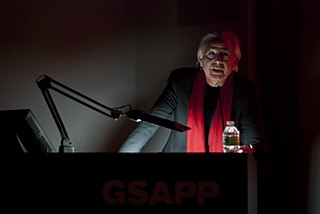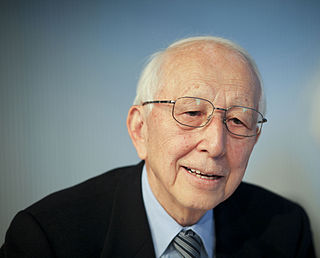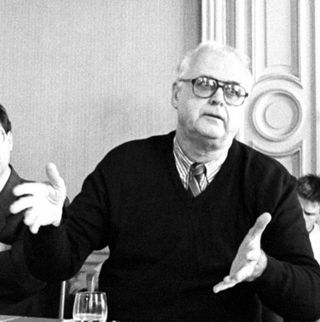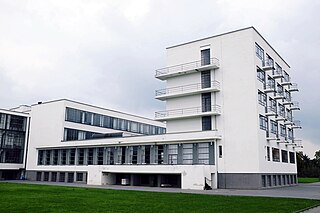Related Research Articles

The Staatliches Bauhaus, commonly known as the Bauhaus, was a German art school operational from 1919 to 1933 that combined crafts and the fine arts. The school became famous for its approach to design, which attempted to unify individual artistic vision with the principles of mass production and emphasis on function.

Walter Adolph Georg Gropius was a German-American architect and founder of the Bauhaus School, who, along with Alvar Aalto, Ludwig Mies van der Rohe, Le Corbusier and Frank Lloyd Wright, is widely regarded as one of the pioneering masters of modernist architecture. He is a founder of Bauhaus in Weimar (1919). Gropius was also a leading architect of the International Style.

Bernard Tschumi is an architect, writer, and educator, commonly associated with deconstructivism. Son of the well-known Swiss architect Jean Tschumi and a French mother, Tschumi is a dual French-Swiss national who works and lives in New York City and Paris. He studied in Paris and at ETH in Zurich, where he received his degree in architecture in 1969.

The International Style or internationalism is a major architectural style that was developed in the 1920s and 1930s and was closely related to modernism and modernist architecture. It was first defined by Museum of Modern Art curators Henry-Russell Hitchcock and Philip Johnson in 1932, based on works of architecture from the 1920s. The terms rationalist architecture and modern movement are often used interchangeably with International Style, although the former is mostly used in the English-speaking world to specifically refer to the Italian rationalism, or even the International Style that developed in Europe as a whole.

Postmodern architecture is a style or movement which emerged in the 1960s as a reaction against the austerity, formality, and lack of variety of modern architecture, particularly in the international style advocated by Philip Johnson and Henry-Russell Hitchcock. The movement was introduced by the architect and urban planner Denise Scott Brown and architectural theorist Robert Venturi in their book Learning from Las Vegas. The style flourished from the 1980s through the 1990s, particularly in the work of Scott Brown & Venturi, Philip Johnson, Charles Moore and Michael Graves. In the late 1990s, it divided into a multitude of new tendencies, including high-tech architecture, neo-futurism, new classical architecture, and deconstructivism. However, some buildings built after this period are still considered postmodern.
The New York Five was a group of architects based in New York City whose work was featured in the 1972 book Five Architects. The architects, Peter Eisenman, Michael Graves, Charles Gwathmey, John Hejduk, and Richard Meier, are also often referred to as "the Whites." Other architects and theorists have been associated with the group, including Werner Seligmann, Kenneth Frampton, Colin Rowe, and Gwathmey's partner Robert Siegel.

Fumihiko Maki is a Japanese architect who teaches at Keio University SFC. In 1993, he received the Pritzker Prize for his work, which often explores pioneering uses of new materials and fuses the cultures of east and west.
Ludwig Karl Hilberseimer was a German architect and urban planner best known for his ties to the Bauhaus and to Mies van der Rohe, as well as for his work in urban planning at Armour Institute of Technology, in Chicago, Illinois.

Hans Emil "Hannes" Meyer was a Swiss architect and second director of the Bauhaus Dessau from 1928 to 1930.

John Quentin Hejduk was an American architect, artist and educator of Czech origin who spent much of his life in New York City. Hejduk is noted for having had a profound interest in the fundamental issues of shape, organization, representation, and reciprocity.

William Wilson Wurster was an American architect and architectural teacher at the University of California, Berkeley, and at the Massachusetts Institute of Technology, best known for his residential designs in California.

Deconstructivism is a movement of postmodern architecture which appeared in the 1980s. It gives the impression of the fragmentation of the constructed building, commonly characterised by an absence of obvious harmony, continuity, or symmetry. Its name is a portmanteau of Constructivism and "Deconstruction", a form of semiotic analysis developed by the French philosopher Jacques Derrida. Architects whose work is often described as deconstructivist include Zaha Hadid, Peter Eisenman, Frank Gehry, Rem Koolhaas, Daniel Libeskind, Bernard Tschumi, and Coop Himmelb(l)au.

Eliot Fette Noyes was an American architect and industrial designer, who worked on projects for IBM, most notably the IBM Selectric typewriter and the IBM Aerospace Research Center in Los Angeles, California. Noyes was also a pioneer in development of comprehensive corporate-wide design programs that integrated design strategy and business strategy. Noyes worked on corporate imagery for IBM, Mobil Oil, Cummins Engine and Westinghouse.
William G. Lycan is an American philosopher and professor emeritus at University of North Carolina at Chapel Hill, where he was formerly the William Rand Kenan, Jr. Distinguished Professor. Since 2011, Lycan is also distinguished visiting professor of philosophy at the University of Connecticut, where he continues to research, teach, and advise graduate students.
Henry-Russell Hitchcock (1903–1987) was an American architectural historian, and for many years a professor at Smith College and New York University. His writings helped to define the characteristics of modernist architecture.

The New Objectivity is a name often given to the Modern architecture that emerged in Europe, primarily German-speaking Europe, in the 1920s and 30s. It is also frequently called Neues Bauen. The New Objectivity remodeled many German cities in this period.

Karen Bausman is an American architect. Bausman is the Eliot Noyes Chair at the Graduate School of Design, Harvard University, and the Eero Saarinen Chair at Yale School of Architecture, Yale University, the only American woman to hold both design chairs.

Sarah M. Whiting is an American architect, critic, and academic administrator. Whiting is currently Dean and Josep Lluís Sert Professor of Architecture at Harvard Graduate School of Design, in addition to being a founding partner of WW Architecture, along with her husband, Ron Witte. She previously served as Dean and William Ward Watkin Professor of Architecture at Rice School of Architecture. In addition to her work as an academic administrator, Whiting is most commonly identified as an intellectual figure within the field of architecture's "post-critical" turn in the early 2000s.
Stanford Anderson was an American architectural historian and professor. He taught architectural history, theory and urban form at the Massachusetts Institute of Technology's Department of Architecture from 1963 until 1991, and again from 2005 until the end of 2014 upon retirement. As an author, he has been collected by libraries.
Architecture and Modernity: A Critique is a 1999 architecture book by the architectural theoretician and historian Hilde Heynen.
References
- ↑ Hays, K. Michael (April 8, 1979). "Reference, coherence, meaning : a realist epistemology of art" – via dspace.mit.edu.
- ↑ "Graduate Alumni by Name in HTC or with HTC Direction". Massachusetts Institute of Technology . Retrieved 2011-07-13.
- ↑ Hays, K. Michael (April 8, 1990). "Modernism and the posthumanist subject : the architecture of Hannes Meyer and Ludwig Hilberseimer" – via dspace.mit.edu.
- ↑ "Knotty But Nice - The Boston Globe". www.boston.com.